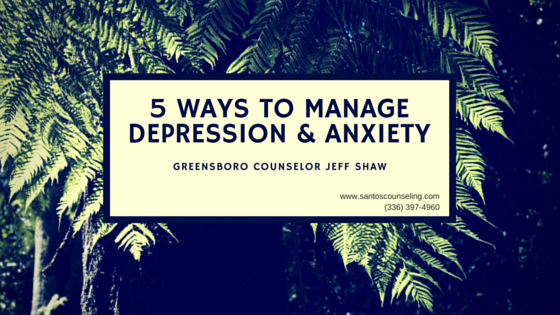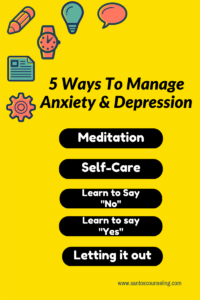5 Tips To Manage Anxiety And Depression
1. Practice Meditation To Reduce Anxiety
With meditation, you have several options to choose from. You can join a meditation class – something related to yoga or Pilates will do just fine. Or if you are squeezing for time, then short periods of meditation can work as well. A simple strategy is to give yourself 5 to 10 minutes in the car, in the bathroom, or pretty much anywhere that you can be alone. During this time – allow yourself to take 4 to 6 really deep breaths.
This strategy helps you:
- Simply reset the clock of stress.
- Catch a break.
- Regain your sanity.
- Regain control over the situation.
- Manage your stress and anxiety.
2. Write In A Therapy Journal To Manage Depression
I don’t like to limit the option to only writing – as some people simply do not enjoy writing. With today’s technology – there are options such as typing, texting, audio or video recording, or anything that you can come up with that documents your thoughts. You can document your thoughts by recording them on your smartphone or by adding an Evernote app to your phone to jot down thoughts during the day.
Ideally, it’s best practice to spend at minimum 10 minutes – while later reflecting back on how you feel now versus then. One small tip: different environments can bring out varying emotions. For instance, documenting in your car outside of work can be very different than at home in your room.
This strategy can help:
- Reduce tension or stress brought on by the day.
- Focus and concentrate on what’s important.
- Reduce anxiety or worry.
3. Try Saying YES To Improve Your Mood
In some ways, I’m kind of quoting the movie “Yes Man” with Jim Carrey but only in thought. The purpose of saying “yes: is to help with gratitude and control. We often travel through life with a boulder over our heads. The boulder represents stress, anxiety, depression, and many more troubling emotions or distressful symptoms. Yet, during the minimal times that we allow ourselves to let go of control, there tend to evolve positive outcomes.
Saying “Yes” – has limits. Be smart on what you say “yes” to, while making sure that when you do it helps with your overall emotional stability.
This strategy helps with:
- Allowing you to feel happier.
- Providing more opportunities to experience positive thoughts.
- Feeling a sense of accomplishment.
4. Build Empowerment With By Saying NO
Well – I don’t think there is a movie for saying “no”. This technique works in the same manner as the one above. You may be the type of person who feels obligated to say “yes” and when you do not say “yes” you experience an uncomfortable feeling. A feeling that makes you feel as if you did something wrong or let someone down. This feeling may be associated with anxiety or personal frustration from what you said. Just say “no”. Think about what it is that the other person is asking you – process it – and if you find it harmful or in any way negative to your mental well-being “say no”.
This strategy helps with:
- Learning to have a “voice” and feel empowered.
- Creating a new self-care skill.
- Creating healthy boundaries.
5. Practice Self-Care To Regulate Your Mood
Just as the title says – “treat yourself”. Make it part of your weekly routine – honestly- I suggest a daily routine. Why not? You work hard each and every day. Why not present some sort of “treat” = “self-care” for yourself? The healthier and happier you are the better you will perform, the better you will feel and the happier people around you will feel. Trust me, if you are an exhausted mother – your husband or kids will notice.
Ways to include self-care in life:
- 10 minutes – 10 times per day give yourself some sort of treat. This can be listening to a few of your favorite tunes or bundling up a few 10 minutes to get your nails done.
- Get your nails done once a month.
- Go for a walk.
- Have someone give you a massage.
- Read your favorite book with no distractions.
- Ask your spouse to watch the kids while you lock yourself in your room with NetFlix.





